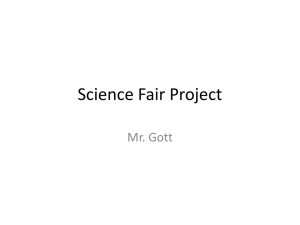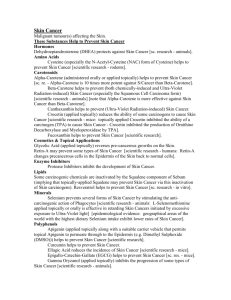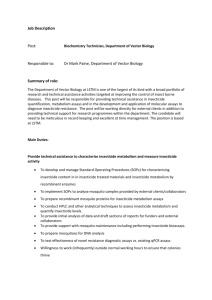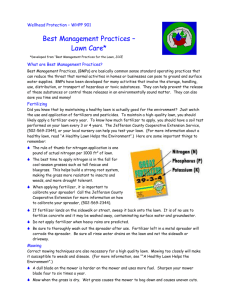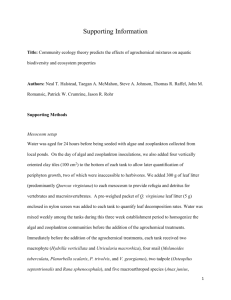Scientific Method
advertisement
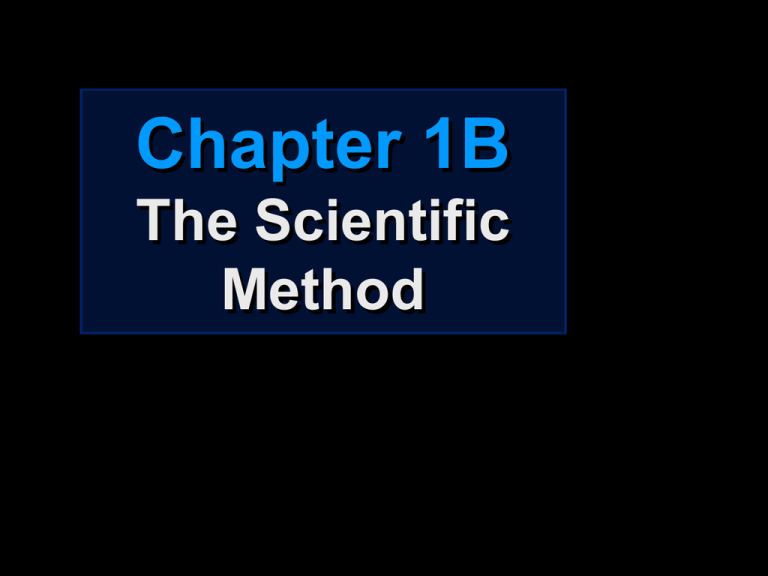
Chapter 1B The Scientific Method The Scientific Method A logical procedure for choosing an answer to a question Using the Scientific Method • Define the problem. • Do preliminary research. • Form a hypothesis. A Hypothesis An educated guess that attempts to answer a problem Example 1 THE PROBLEM A salamander escapes from an aquarium and is found the next day very dried out and dead. The next day a baby alligator escapes and is found a day later in good shape. Example 1 POSSIBLE HYPOTHESIS Although both alligators and salamanders are aquatic, alligators can survive on land longer than salamanders. Example 2 THE PROBLEM Two jars of home-canned beans are placed on a shelf. Both were canned at the same time. After a month, one jar is still good. The other jar is discolored and smells bad. Example 2 POSSIBLE HYPOTHESIS If jars are not sealed properly, bacteria will destroy food. Steps of the Scientific Method 1. Set up an experiment or survey. Steps of the Scientific Method 2. Observe the experiment or survey. Steps of the Scientific Method 3. Collect the information and record it. Steps of the Scientific Method 4. Classify the data. Data The recorded information from an experiment or survey Steps of the Scientific Method 5. Analyze the data. Steps of the Scientific Method 6. Choose the best answer. Steps of the Scientific Method 7. Verify the answer. Steps of the Scientific Method 8. Predict future results. Workability The ability to apply scientific knowledge to similar situations Controlled Experiments • Two groups with the difference being one variable –Control group = constant –Experimental group = exposed to the variable Controlled Experiments –Independent variable = the factor being tested; the difference between the control and experimental groups –Dependent variable = the factor being measured; influenced by the independent variable Controlled Experiments • Only the experimental group is exposed to the independent variable. • Multiple variables cause an experiment to be invalid. Sample Experiment 1 Problem: Does fertilizer with insecticide help my lawn grow faster than fertilizer without insecticide? Hypothesis: Fertilizer with insecticide will make my lawn grow faster. Sample Experiment 1 Procedure: On one side of lawn, put just fertilizer. On other side, put fertilizer with insecticide. Keep all other factors equal. Measure and record growth. Sample Experiment 1 What is the independent variable? insecticide Sample Experiment 1 What is the dependent variable? growth of the lawn Sample Experiment 1 Which side of the lawn is the experimental group? the side with insecticide Sample Experiment 1 Which side of the lawn is the control group? the side without insecticide Sample Experiment 1 What variables do you need to control? type of fertilizer, amount of water, amount of sunlight, etc. Sample Experiment 2 Problem: Does giving mice extra vitamin B help them grow? Hypothesis: Giving mice extra vitamin B will cause them to grow faster. Sample Experiment 2 Procedure: Give both groups of mice the same food. In one groups’ food, place 10 mg of vitamin B. Do this every day for a month. Keep all other factors equal. Measure and record growth. Sample Experiment 2 What is the independent variable? 1. 2. 3. 4. Food Growth of the mice Vitamin B There is no independent variable in this experiment. Sample Experiment 2 What is the dependent variable? 1. 2. 3. 4. 5. Food Growth of the mice Lifespan of the mice Vitamin B There is no dependent variable in the experiment. Sample Experiment 2 Which group is the experimental group? 1. The group that received vitamin B 2. The group that did not receive vitamin B 3. Both groups were experimental groups. Sample Experiment 2 Are there any variables to control in this experiment besides the amount of vitamin B given to the mice? 1. Yes 2. No Limitations of Science • Must deal with observable, measurable phenomena –Cannot deal with matters of faith • Can only describe, not explain –Cannot answer the question “why” Limitations of Science • Observations may be inaccurate. • Observations and interpretations are subject to bias. –Bias is what a person wants to believe. Limitations of Science • Impossible to limit completely the variables • Results must be repeatable to be considered valid. Limitations of Science • Cannot make value judgments or moral decisions • Cannot prove or disprove universal statements • Cannot establish truth Science & The Christian • We have the responsibility to be wise stewards over God’s creation. –To “subdue” does not mean to “destroy.” Genesis 1:28 And God blessed them, and God said unto them, Be fruitful, and multiply, and replenish the earth, and subdue it: Genesis 1:28 and have dominion over the fish of the sea, and over the fowl of the air, and over every living thing that moveth upon the earth. Science & The Christian • Science is not in itself good or bad. –Science can supply answers to some physical problems. –How man uses science can be good or bad. Science & The Christian • Science cannot replace faith in God. –Science is not the answer to man’s ultimate problem. Science & The Christian A Christian should look on science as an opportunity given to him by God to learn as much as he can about God’s creation. Steps of the Scientific Method 1. Set up an experiment or survey. 2. Observe the experiment or survey. 3. Collect & record the data. Steps of the Scientific Method 4. Classify the data. 5. Analyze the data. 6. Choose the answer. Steps of the Scientific Method 7. Verify the answer. 8. Predict future results.

